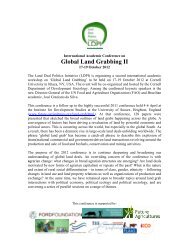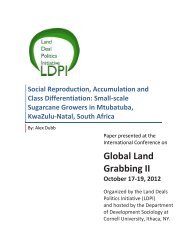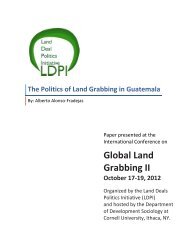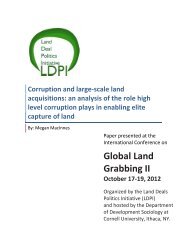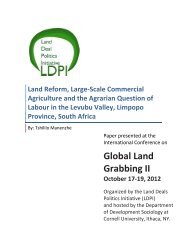Theorizing Sovereignty in Empty Land - Contested Global Landscapes
Theorizing Sovereignty in Empty Land - Contested Global Landscapes
Theorizing Sovereignty in Empty Land - Contested Global Landscapes
- No tags were found...
Create successful ePaper yourself
Turn your PDF publications into a flip-book with our unique Google optimized e-Paper software.
especially nomadic pastoralists, and their 'ancestors,' the '<strong>in</strong>vad<strong>in</strong>g Arabs' of the eleventh century, for<br />
deforest<strong>in</strong>g and desertify<strong>in</strong>g North Africa" (Davis 2007: xii). Degradation narratives justified both<br />
outright expropriation of land and the development of an <strong>in</strong>stitutional <strong>in</strong>frastructure for forestry and range<br />
management, agricultural <strong>in</strong>vestment, and the political conta<strong>in</strong>ment of mobile pastoralists constructed on<br />
the premise that extensive pastoralism was unproductive at best, destructive at worst. These narratives<br />
cont<strong>in</strong>ue to shape the political economy of Morocco's rangelands. As <strong>in</strong> sub-Saharan Africa,<br />
discrim<strong>in</strong>atory policies towards mobile pastoralists comb<strong>in</strong>ed with imported models of pastoral<br />
development to create, not avert, environmental degradation and commoditize the livestock market,<br />
driv<strong>in</strong>g small herdowners out of the sector and concentrat<strong>in</strong>g wealth <strong>in</strong> a few large livestock owners<br />
(Gertel and Breuer 2007). Even if policies towards the sector have become more nuanced <strong>in</strong><br />
contemporary Morocco, the environmental narratives Davis describes played a central role <strong>in</strong> produc<strong>in</strong>g<br />
the current marg<strong>in</strong>ality of the pre-Saharan rangelands. The commoditization of the livestock market has<br />
been compounded by chronic droughts <strong>in</strong> what some observers say is a progressive desiccation caused by<br />
global warm<strong>in</strong>g (Benassi 2008). If the lands surround<strong>in</strong>g Ouarzazate appear unused, it is <strong>in</strong> part because<br />
the opportunistic use of pastoral resources and mobility of transhumant pastoralists have long been<br />
<strong>in</strong>visible or constituted an unproductive land use to policy makers. These narrow conceptions of land use<br />
and mobility do not recognize the way any given piece of land derives it mean<strong>in</strong>g or importance as part of<br />
a much broader spatial, ecological, and social system. Ouarzazate's steppe may also appear unused<br />
because pastoralism has shifted from a cornerstone of the region's livelihood systems to an <strong>in</strong>supportable<br />
economic risk for many; environmental and economic changes of the past three decades have forced<br />
<strong>in</strong>creas<strong>in</strong>g numbers of households from the livestock sector.<br />
For Moroccan policymakers, the conversion of a relatively small 3,000 ha parcel that did not even<br />
constitute good pasture over to <strong>in</strong>dustrial use offers a potentially transformative way to "mobilize"<br />
Morocco's millions of hectares of collective land that by virtue of topography or ra<strong>in</strong>fall are unsuited for<br />
cultivation. If pastoralism is no longer a reliable livelihood strategy, f<strong>in</strong>d<strong>in</strong>g alternative land uses is<br />
arguably a wise direction to go. The Moroccan government has long debated how to render these lands<br />
12



